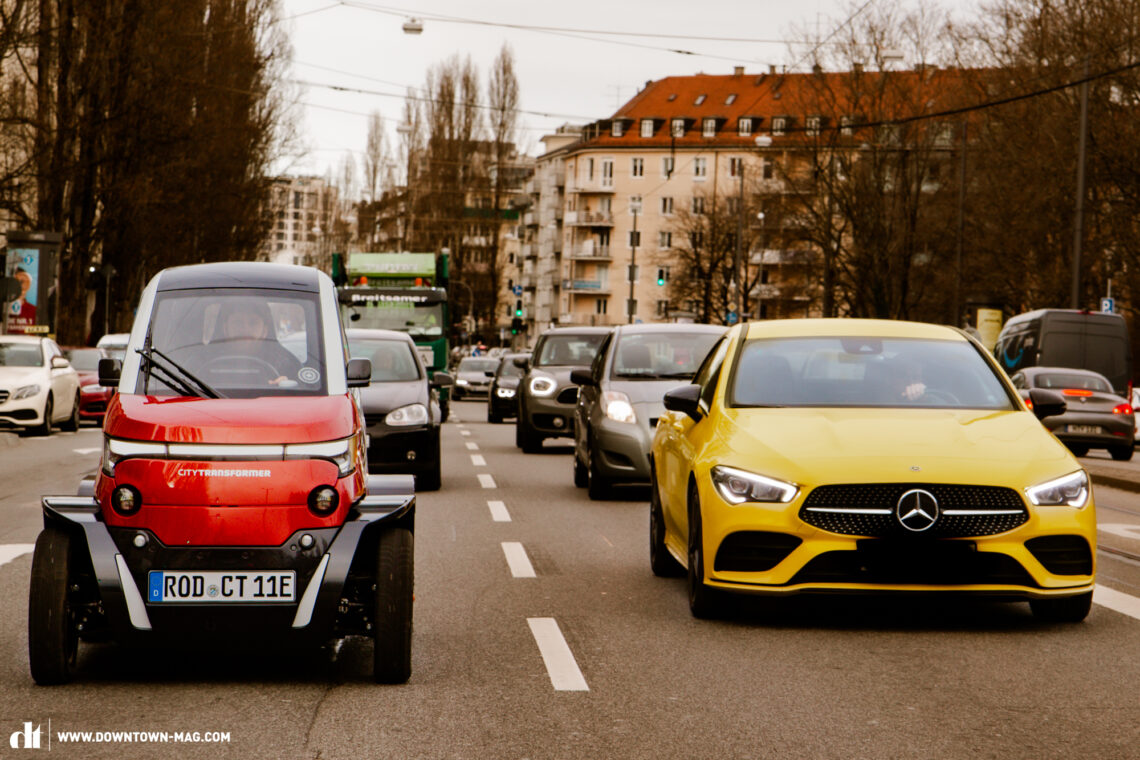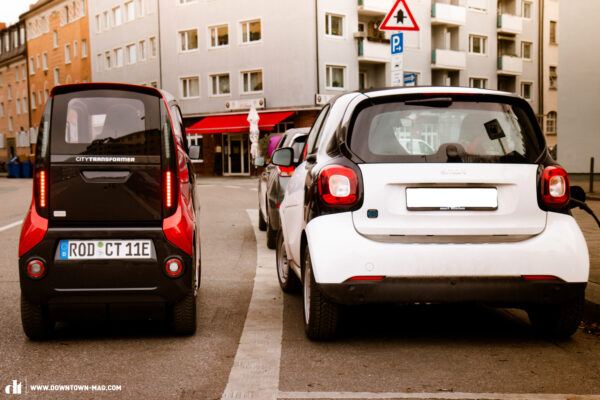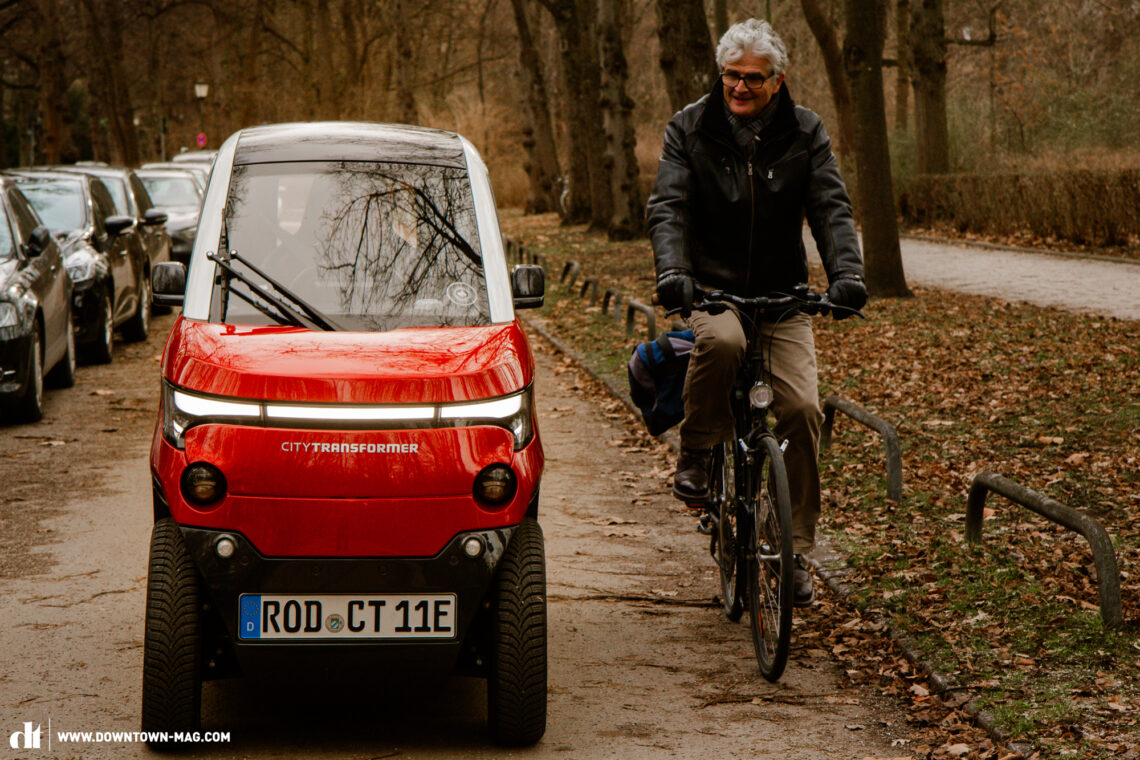City Transformer want to rethink urban mobility with their eponymously named electric vehicle. The 2-seater was developed in cooperation with the forefather of the Smart, and features a variable chassis. Can the City Transformer combine the safety and space of a car with the agility and footprint of a motorcycle? And what hurdles must it overcome?
You can find all electric Cars in our big EV special “Which is the best electric car of 2023?“, where you can also check out our personal EV buyer’s guide – free of charge!

There are too many and too large cars crowding the streets and inner cities of almost every city in the world. According to the ADAC, every car in Germany is used for an average of just one hour per day, of which 35% is for finding a parking space in inner-city traffic alone. On top of that, there is usually just one person in the car. The rest of the time, the steel behemoths do nothing but occupy public space that is meant for humans. With almost 50 million cars in Germany and an average parking space of about 15 square metres, you quickly get to over one hundred thousand football fields of lost space. This is where the Israeli start-up City Transformer come in, who want to combine the best features of both worlds with their car and motorcycle hybrid. The aim is to combine the safety and space of a car with the manoeuvrability and footprint of a motorcycle. All electric, of course. We were able to take a closer look at the City Transformer in Munich and even take the prototype for a short drive in the BMW capital. Read on to find out what we think of the concept and implementation of this mini EV.

The City Transformer – A feasible solution?
With the City Transformer, the aim is to get the current development of automobiles, which keep getting larger and heavier, to make a 180-degree turn. How so? The concept is based on making the smallest possible car for up to two people or one person and a lot of groceries. We first became aware of the City Transformer at the IAA 2021. It belongs to the so-called L7e class: light, four-wheeled motor vehicles that fit in somewhere between ebikes and regular EVs, and promise to be a micro-mobility game changer. To ensure that the safety of the occupants doesn’t suffer, the production models will rely on all conventional assistance systems such as ESP and ABS, which isn’t mandatory for this vehicle class. The heart of the City Transformers is a variable platform with a track width that can be widened from 1 to 1.40 m. This patented technology is intended to ensure stability at high speeds and make finding a parking space much easier when it’s retracted. In addition, the narrow width of just one metre should take the stress out of threading your way through the chaos of inner-city traffic. However, at 1 metre wide, the speed is limited to 45 km/h due to the design. If that’s not quick enough for you, a simple transformation to 1.40 m wide will let you go twice as fast. The vehicles will also feature a sharing option, allowing them to be rented from one private person to another – a kind of Carbnb. It goes without saying that the City Transformer turns a lot of heads with its shape-shifting capabilities.


The City Transformer in detail
There are two prototypes of the City Transformer, both of which were built near Munich. However, the specs are almost identical to the planned production vehicles. The City Transformer is designed to accommodate two people, the passenger sitting behind the driver. When the rear seat is folded down, you have luggage capacity of around 350 l. That’s enough for your weekly shopping or to stock up on beer. To keep your liquid gold from getting shaken up, the track width can be widened from 1 to 1.40 m within 2–4 seconds, thus ensuring a more stable ride. In city mode with a width of 1 m, the speed is limited to 45 km/h, primarily intended for inner-city traffic and parking. This is due to safety reasons and is also intended to allow access to zones that can only open to vehicles with a top speed of 45 km/h. You can find these in some Italian inner cities, so-called ZTL (zona traffico limitato). Who knows, maybe we’ll see such zones being introduced in the rest of Europe in the future? In performance mode, at a width of 1.40 m, the top speed is 90 km/h, and the company claim that you should get a range of up to 180 km. Measuring 2.50 x 1.40/1.00 x 1.50 m (L x W x H), the City Transformer is said to have a turning circle of 8.5 m. For comparison: the Smart EQ is 2.7 m long, has a turning circle of 6.95 m, and reaches a top speed of 130 km/h. On the other hand, Smart’s urban runabout is almost 1.70 m wide, too.


Weighing in at 560 kg including the battery, the City Transformer is driven by two rear wheel motors, producing a total 15 kW. The energy is supplied by a 16 kWh battery that weighs 110 kg, which can be charged to 80% in less than 30 minutes using the quick charge function, according to the start-up. This sets the vehicle apart from the competition in the L7e class, as it’s the only option with CCS fast charging technology currently on the market. Vehicles weighing less than 450 kg (excluding battery) generally fall into this category. In contrast to normal size EVs, there are no subsidies for this vehicle class. However, City Transformer want to help get subsidies introduced for L7e vehicles. The team are also striving to ensure that you can park vehicles like this in motorcycle parking bays, thereby making the search for a parking space even easier. The current price is 15,000 Euro (1,000 Euro discount) until April 1st. After this date the price will be 16,000 Euro. However, since they’re still looking for manufacturers and further investors, the price calculation is a very rough estimate at this point. With regard to the production sites, City Transformer plan to manufacture at least 80% of their vehicles in Europe to keep supply chains short and enable sustainable production. So far, they’ve targeted Germany, France and Italy as possible production locations.

City Transformer’s vision
There’s a very ambitious team behind City Transformer. The first-generation vehicle should already come equipped with safety systems like ABS and ESP and allow for regenerative braking. They also want to fit comfort features such as air conditioning, heated seats, and electric windows. City Transformer are planning to offer an optional roof box to expand the luggage capacity of the mini EV, and a fancy scissor door upgrade, saving even more space as they rotate upwards. For the CT 2 generation, the developers want to introduce partially autonomous driving, with the third generation being completely autonomous. When it comes to connectivity, City Transformer are collaborating with Bosch. They want to offer additional mobility services via an app, like locating the car, locking and unlocking it remotely, or having it automatically adopt your personal pre-sets. These features should also be available with the previously mentioned sharing option. The baby Optimus Prime isn’t just targeted at your average consumer but will also be marketed to rental companies in large cities or as a first-response vehicle. The idea is that a small vehicle can easily weave its way through traffic jams without an emergency lane.


First test drive with the City Transformer
The words that come to mind when you first see the City Transformer are “small but nifty”. From the outside, the continuous light strip on the front, and the scissor doors catch your eye. The interior, on the other hand, is rather minimalistic. You’ve got two displays to convey the most important information to the driver. The steering wheel looks tidy, and the gear selector needs no explanation. In terms of finishing quality, it all looks quite refined for a prototype. That said, the software still takes a while to start up when switching the vehicle on, though the hardware seems production ready. One thing is certain, the baby Optimus Prime already garners a lot of attention on the road.



We came to several conclusions during our little tour of the west of Munich. The City Transformer isn’t very comfortable for two. The rear seat is tiny for adults and won’t cut it on longer distances. Driving alone, you’ll get through inner-city traffic comfortably, and the heating will keep you warm on frigid days. The wide track width makes the handling feel safe and invites you to put your foot down to test the electric motors. The only disadvantage is that the extended wheel arches aren’t clearly visible from the interior, requiring a little practice before you can accurately estimate the vehicle’s width. With the arches retracted, there’s no guessing needed, and the integrated camera that replaces the central rear-view mirror provides a clear view of what’s behind. However, the narrow mode of the City Transformer suffers considerably more body roll through the corners, which quickly has you taking your foot off the accelerator. City Transformer hope to correct this behaviour with the help of ESP on the production model. Accelerating from 0 to 50 km/h is claimed to take 5 seconds, though doing so (still) makes quite a racket. Widening and retracting the chassis also produces a clear whirring, giving off Optimus Prime vibes.


Our take on the City Transformer
The City Transformer had a different look when it was introduced in 2018. They’ve made a lot of external changes since, but they’re yet to go into production. This isn’t uncommon for start-ups, and other companies like Microlino have also struggled repeatedly with setbacks. However, it remains to be seen whether the City Transformer can go into production and hit the roads next year as planned. It’s unlikely if you ask us. Production requires enormous financial resources, for which City Transformer will have to further investors, and they’re yet to determine where they’ll manufacture. Once that’s been sorted out, it also takes a lot of know-how and expertise to manage ad hoc quality control!


Whether the City Transformer will become a catalyst of urban transformation or whether our cities will need to be restructured first remains to be seen. In any case, a small amount of political assistance won’t hurt, be it subsidies, regulations, or restrictions on private transport in inner cities. The City Transformer is an exciting concept that still has some compromises in terms of handling and usability. Without a doubt, however, the City Transformer is a highly future-oriented solution that is ahead of its time.

Conclusion on the City Transformer
The shape-shifting chassis of the City Transformer is an innovative and excellent approach to adapting to different situations. This and the width of just one metre in city mode are its standout features. It’s too cramped for two people and the large turning circle is somewhat disappointing. The City Transformer also seems to be a long way off from being launched, which keeps getting announced but then postponed. It’s a common start-up problem: the concept is exciting and promising, but they’ll have to deliver before the hype and interest fizzle out!

Find more information at citytransformer.com.
All tested e-cars: City Transformer Prototyp | Fiat 500e | Honda e | KIA EV6 | Opel Rocks E | Polestar 2 | Porsche Taycan | Smart EQ Forfour | Tesla Model 3 Dual Motor Long Range | VW ID.3 | VW ID.BUZZ
Words: Gabriel Knapp Photos: Manfred Schmitt







